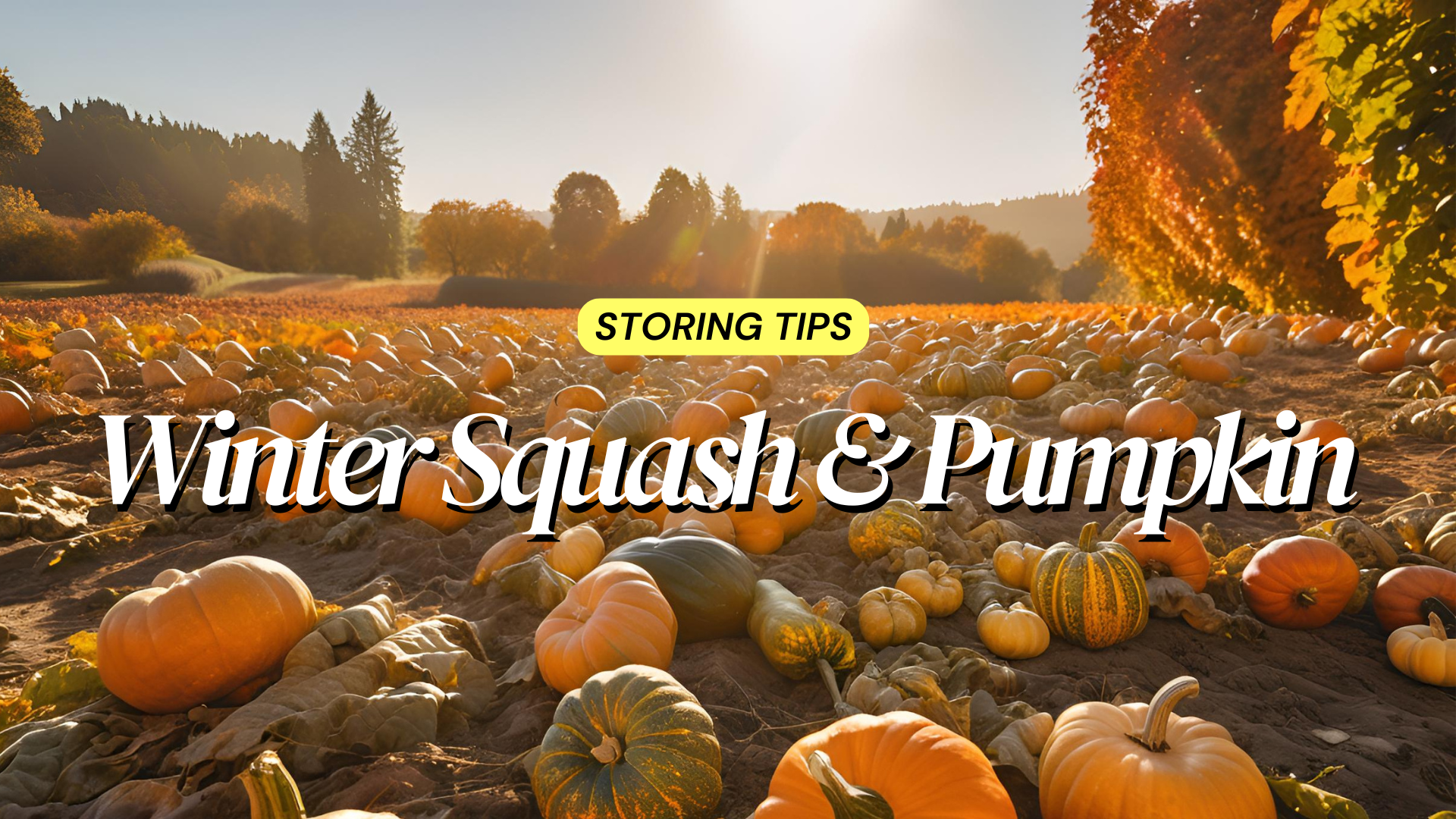During the fall harvest season, squash and pumpkins are popular vegetables to enjoy in both sweet and savory recipes. From the Louisiana sweet potato to spaghetti squash and butternut to acorn squash, there are scores of options to enjoy all winter long.
Properly storing pumpkin and winter squash will help retain the best flavor while preserving most of the vital nutrients that your body needs. The goal of this ultimate guide is to provide you with all of the tips you need for long-term vegetable storage of winter squash and pumpkins so that you have the freshest produce available.

Importance of Proper Storage
Before we delve into winter squash storage and pumpkin preservation, it’s good to understand why storage is important. Incorrect storage leads to spoilage, which not only shortens storage time but also robs vegetables of their best flavors and nutrients. Spoilage may foster fungal growth by drainage, which may cause foodborne illness.
Proper storage not only means retaining quality but also enjoying each type of vegetable over a longer period of time. Since it's a way of food preservation, it also means that during the off-season, you can eat them until they become available in stores again. That reduces food waste and, by extension, your overall budget.
Most pumpkins and squash varieties for storage can be kept for up to 3 months when cared for properly. Once cut, start with shorter storage of 1-2 days and longer up to 2 weeks.
Selecting the Best Squash and Pumpkins for Storage
Choose a squash or pumpkin that is firm with moist, unblemished skin. Most mature varieties of butternut and smaller squashes have well-developed vines and dry leaves. Pumpkins with a fully orange rind generally have mature fruit. For freshness, purchase squash, and pumpkins as soon after harvest as possible—or, better yet, grow them yourself.
Varietals in the Cucurbita maxima category typically store the longest. The 'Banana' and Hubbard squashes have a well-earned reputation for winter squash storage. Butternuts and pumpkins also store well, especially pumpkin varietals with green skin.

Preparation Techniques for Long-Term Storage
These remarkable warm-season crops offer exceptional flavors, but you must recognize their vulnerability to cooler temperatures—anything below 45 degrees Fahrenheit can harm them. To achieve an abundant harvest, collecting these fruits before the frost arrives is essential. While they can tolerate slight drops to 35 degrees Fahrenheit, a swift return to warmer conditions can significantly reduce chilling damage, preserving their outstanding quality.
Harvesting pumpkins and winter squash from September to October is a golden opportunity you shouldn’t miss. Even after being picked from the vine, pumpkins and winter squash remain alive—a fact that highlights the importance of effective curing squash and pumpkin preservation methods to extend their post-harvest lifespan. Mature pumpkins and winter squash not only last longer but also are far superior to their immature counterparts. For instance, when winter squash, such as Butternut, Acorn, and Hubbard, are fully mature, they develop tough skins that won't easily puncture with your thumbnail. In contrast, mature fruits exhibit dull, dry skin, a clear distinction from the fresh, glossy appearance of immature fruit.

To ensure optimal storage longevity for your pumpkins and winter squash, it's crucial to allow them to ripen fully on the vine. Be aware that dead vines do not necessarily signify that the fruits are mature. If the vines perish prematurely due to factors like disease or drought, the chances are high that the fruits remain immature and won't store well. A more dependable sign of ripeness is the development of stem corking, which appears as brown, woody stripes at the stem's junction with the fruit, along with some shrinkage of the stem itself. This critical marker indicates that the fruit is starting to detach from the vine, meaning it is no longer receiving energy from the plant, and this coincides with the hardening of the rind. It's crucial to handle these fruits delicately to prevent any cuts or bruises, which could damage their quality and lead to issues with preventing rot.
Optimal Storage Conditions
When considering the optimal storage conditions for winter squash and pumpkin varieties, three key aspects are critical: temperature, humidity, and space.
Temperature
To achieve the best quality for your pumpkins and squash varieties for storage, it’s essential to keep them at temperatures between 50 and 55 degrees Fahrenheit. Going below 50 degrees can lead to chilling injuries and decay, both of which would compromise their taste and aroma. By maintaining this optimal storage conditions range, you ensure that these delicious vegetables retain their maximum flavor. While brief exposure to slightly cooler temperatures in the upper 30s to 40 degrees might seem manageable, it's crucial to understand that extended periods in such conditions can result in quick spoilage and a decline in taste. Prioritize your squash and pumpkins' quality by sticking to the recommended storage temperatures!
Humidity
For optimal preservation, it is important that the fruit is completely dry prior to storage, with the goal of maintaining a relative humidity level between 50% and 70%. Be aware that excess humidity can lead to condensation forming on the fruit, increasing the likelihood of disease. Conversely, low humidity levels can result in dehydration, damaging the fruit. Additionally, proper ventilation is paramount during storage; it facilitates adequate air circulation, which is key to preventing rot and moisture accumulation. By storing squash in a space with good airflow, you significantly reduce the chance of moisture buildup, thus thwarting decay and prolonging the life of your produce.
Space
The ideal setup for root cellar storage is a dark, unlit place with plenty of room and fresh air. This means that you could set up some shelving units in your barn's deepest and darkest corner or use a big upstairs cupboard to store your squash. Consider using a garage for your pumpkins and squash; it’s an ideal choice as long as they are placed on shelves elevated off the ground. Adding a layer of straw will effectively keep them dry and in good condition. Be cautious—using newspaper or paper bags is not advisable since they can trap too much moisture. It's also crucial to store pumpkins and squash away from apples and pears. This is because these ripening fruits emit ethylene gas, which can quickly speed up the decay of your squash. It is advisable to conduct weekly inspections of your stored pumpkins and squash, ensuring the removal of any specimens that exhibit signs of softness. Taking these steps will ensure your produce stays fresh longer and aids in preventing rot.
By carefully following these root cellar storage methods, you can preserve your harvest effectively. You can easily customize and combine these tips to cater to your family’s preferences, providing them with a beloved food source that will last throughout the season. Don't miss out on the opportunity to enjoy your harvest for longer!








